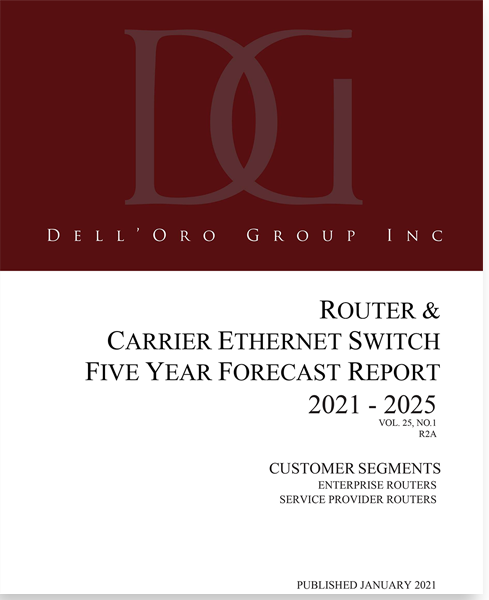The Service Provider Router market—which includes Core, Edge, and Aggregation segments—held up reasonably well in 2020 despite the macroeconomic turmoil caused by the COVID-19 pandemic. Large-scale network operators, whether they be telecom, cable MSO, or cloud service providers, pulled back on some infrastructure investments, but on the whole, continued to add capacity to their networks to meet the expanding traffic loads. The worldwide SP Router market declined just one percent in 2020.
In our new 5-year forecast report, we are predicting that the worldwide SP Router market will resume growth in 2021 and continue to expand annually through 2025. To be clear, the SP Router market is a mature one, and our projected compounded annual growth rate (CAGR) in the low single-digits reflects the state of the market. Nonetheless, there are some clear opportunities for growth with emerging technologies and the evolution of network architectures. Our forecast highlights the emergence of 400 Gbps and evolution of 5G transport infrastructures:
Demand for 400 Gbps capable routers will start to ramp in 2021 and become the growth engine for high capacity network expansion for the foreseeable future. Adoption will be mainly for core network use cases, but with the need for high capacity IP transport being pushed to the edge of networks, 400 Gbps will see broader adoption than 100 Gbps in its initial stages.
Coinciding with the emergence of 400 Gbps routing technologies are disaggregated router solutions in which the network operating system software is sold independently from the hardware, and the availability of 400ZR optical modules with a potential reach of 120 kilometers. These technologies bring new dynamics to the market that potentially alter the competitive landscape.
The global transition to 5G radio access networks (RAN) technologies will generate long-term demand for IP transport network upgrades. Higher capacity products will be an important aspect of the upgrade cycle, but service providers will require entirely new levels of functionality, scalability, and operational efficiencies to deliver the high-value 5G services they envision. What this means to that IP and software functionality will be distributed even more broadly across the network infrastructure.
|
 About the Report
About the Report


 About the Report
About the Report